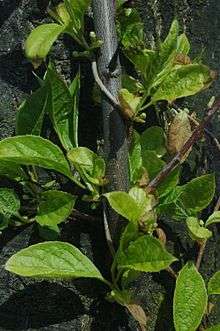Schisandra
| magnolia vine | |
|---|---|
 | |
| Schisandra sinensis | |
| Scientific classification | |
| Kingdom: | Plantae |
| (unranked): | Angiosperms |
| Order: | Austrobaileyales |
| Family: | Schisandraceae |
| Genus: | Schisandra Michx.[1] |
| Synonyms[2] | |
| |

Schisandra (magnolia vine) is a genus of twining shrub that generally climb on other vegetation. Some early publications misspell the name as "Schizandra," but "Schisandra" is correct. Various authors have included the plants in the Illiciaceae [3]
Schisandra is native to Asia and North America, with a center of diversity in China.[2][4][5]
Some species are commonly grown in gardens as ornamentals. It is a hardy deciduous climber which thrives in almost any kind of soil; its preferred position is on a sheltered, shady wall. It may be propagated by cutting off half-matured shoots in August.
Description
Schisandra is native to East Asia, and its dried fruit is sometimes used medicinally. The berries of S. chinensis are given the name wu wei zi in Chinese (五味子; pinyin: wǔ wèi zi), which translates as "five flavor fruit" because they possess all five basic flavors in Chinese herbal medicine: salty, sweet, sour, pungent (spicy), and bitter. In traditional Chinese medicine it is used as a remedy for many ailments: to resist infections, increase skin health, and combat insomnia, coughing, and thirst.[6]
Species
- accepted species[2]
- Schisandra arisanensis - S China incl Taiwan
- Schisandra bicolor - Guangxi, Hunan, Yunnan, Zhejiang
- Schisandra chinensis - Russian Far East, NE China, Korea, Japan
- Schisandra elongata - Java
- Schisandra glabra - Hidalgo, United States (LA AR MS AL TN KY GA FL SC NC)[7]
- Schisandra glaucescens - Chongqing, Hubei
- Schisandra grandiflora - Tibet, Sikkim, Nepal, Bhutan, Assam, Uttarakhand
- Schisandra henryi - S China
- Schisandra incarnata - Hubei
- Schisandra lancifolia - Sichuan, Yunnan
- Schisandra longipes - Guangdong, Guangxi
- Schisandra macrocarpa - Yunnan
- Schisandra micrantha - Manipur, Yunnan, Myanmar
- Schisandra neglecta - Sikkim, Nepal, Bhutan, Assam, Myanmar, Yunnan
- Schisandra parapropinqua - Guizhou, Yunnan
- Schisandra perulata - Thailand, Vietnam
- Schisandra plena - Arunachal Pradesh, Yunnan
- Schisandra propinqua - China, Assam, Nepal, Myanmar, Thailand, Java, Bali
- Schisandra pubescens - Sichuan, Hubei
- Schisandra pubinervis - Hubei, Sichuan
- Schisandra repanda - Korea, Japan
- Schisandra rubriflora - Arunachal Pradesh, Yunnan, Myanmar, Sichuan
- Schisandra sphaerandra - Sichuan, Yunnan
- Schisandra sphenanthera - China
- Schisandra tomentella - Sichuan
Chemistry
The extract of S. rubriflora, a native of the Yunnan province, was found to contain complex and highly oxygenated nortriterpenoids called rubriflorins A-C.[8]
See also
| Wikimedia Commons has media related to Schisandra. |
References
- ↑ Michaux, André. 1803. Flora Boreali-Americana 2: 218–219, pl. 47.
- 1 2 3 Kew World Checklist of Selected Plant Families
- ↑ Hutchinson, J. 1973. The Families of Flowering Plants, ed. 3. Oxford. Pp. 161-162. Smith, A. C. 1947. The families Illiciaceae and Schisandraceae. Sargentia 7: 1-224.
- ↑ Flora of North America vol 3
- ↑ Flora of China Vol. 7 Page 41 五味子属 wu wei zi shu Schisandra Michaux, Fl. Bor.-Amer. 2: 218. 1803.
- ↑ Panossian A., Wikman G. Pharmacology of Schisandra chinensis Bail.: An overview of Russian research and uses in medicine . Journal of Ethnopharmacology. Vol 118/2 pp 183-212. doi:10.1016/j.jep.2008.04.020
- ↑ Biota of North America Program 2013 county distribution map, Schisandra glabra
- ↑ Xiao, W.-L. et al.. J. Nat. Prod. 2007, Web release : May 10th.
External links
- Schisandraceae [sensu stricto] in the Flora of North America